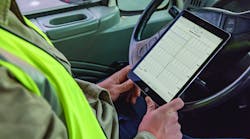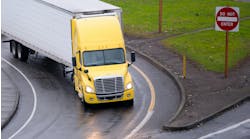Editor's note: This is the second part of a week-long series looking at what fleets need to do ahead of the December deadline to end use of AOBRDs. Click here to read part one.
Any upgrade or change to an electronic logging device (ELD) system requires thorough training, which in some cases can be complicated by drivers and terminals being spread out across North America.
Implementing a training program is a reason why some large and midsized fleets were initially hesitant to begin the transition process, said Walter Kutschal, product manager for Verizon Connect.
Though the December deadline is drawing near, GeoTab recommended fleets review offerings from various ELD manufacturers, and once an option is selected, ask for a pilot program involving a handful of drivers.
While every fleets’ needs may vary, Omnitracs suggested training all truck drivers at the same time, and then following up with a refresher after full implementation is complete. Carefully documenting what ELDs can and cannot track, what data is being collected, and who is seeing the collected data can help ensure a successful transition for drivers.
Tom Cuthbertson, vice president of regulatory compliance at Omnitracs, noted that careful attention must be paid to small details during the migration process from automatic onboard recording devices (AOBRDs) to ELDs. For example, the correct name of the driver, along with CDL number and state issuing the CDL are required in the header of the electronic log. If this information is not correct, it could result in a “form and manner violation,” he said.
Especially for larger operations, David Blackwell, product manager at Coretex, said fleets should treat each terminal and distribution center as a separate business. The rollout should be staggered, with each entity having its own training start and end dates.
A mix of hands-on and classroom or remote training will likely be needed to understand hardware differences, and potentially learn a new software system, according to Mark Schedler, a senior editor with J.J. Keller & Associates.
It is equally as important to train the back-office and maintenance staffs, ensuring they understand the AOBRD/ELD rule tweaks that could alter daily operations.
“More information is needed now in the instance there’s an audit, so ensuring you have policies and resources in place for drivers and the back office is crucial,” said Verizon’s Kutschal.
Cuthbertson pointed out that drivers have primary responsibility when using ELDs. When the back office edits a log, it goes into “pending” state, with the driver needing to approve the change.
During a full rollout, training should also include explaining the ways ELDs could malfunction and what drivers will need to do once a problem is discovered.
Because ELDs trigger drive time at 5 mph, more technicians and other employees who occasionally move vehicles will need their own log-ons. ELDs default to “on-duty, not driving” status when the vehicle has been motionless for five consecutive minutes, unlike AOBRDs.
Proper training can provide a better understanding on how to utilize data obtained from ELDs and can help carriers improve customer scheduling and bidding processes. It can also provide payroll assistance, as GPS data could help to accurately document detention time.
Once training begins, motor carriers should keep pushing forward. It can be difficult for drivers to switch back and forth between AOBRDs and ELDs when they become accustomed to the updated system, warned Doug Schrier, vice president of product and innovation for Pegasus Transtech.
Besides the initial training, fleets should be inquiring about follow-up visits from their provider as well as service contracts to avoid ELD downtime should there be any malfunctions, said Adam Bruttell, vice president of sales and marketing at MiX Telematics.
Coming Wednesday: A look at the various options available to fleets still needing to upgrade to ELDs.



